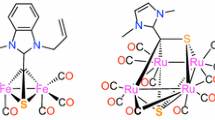Abstract
Many trinuclear metal clusters have structures based on isolated metal triangles with either single bonds (e.g.,M 3(CO)12 whereM = Fe, Ru, Os) or double bonds (e.g., Re3 Cl 3−12 ) along each edge of the triangle. Individual metal triangles can be joined in the following ways to form more complicated triangulated networks: (1) Bridging an edge of a triangle with a new vertex to give rafts in which adjacent triangles share edges; (2) Bridging a vertex of a triangle with a new edge to give bowties in which adjacent triangles share vertices; (3) Capping a triangular face with a new vertex to give a chain of tetrahedra in which adjacent tetrahedra share faces. Such triangulated metal networks are particularly common in osmium carbonyl chemistry and in mixed osmium/platinum carbonyl derivatives. Platinum triangles of the type Pt3L6 are analogous to cyclopropenyl rings and can form sandwiches with one or two mercury atoms in the center such as the mercuric derivative Hg[Pt.3(µ2-2,6-Me2C6H3NC)3] (2,6-Me2C6H3NC)3]2 and the “mercurous” derivative Hg2[Pt3(µ2-CO)3L3]2. Platinum triangles can also be stacked in the absence of “filling” to give [Pt3(µ2-CO)3(CO)3] 2− n (n=2, 3, 4, 5, 6, 10). Metal triangles also form the faces of metal deltahera of which the octahedron, bicapped square antiprism, and icosahedron are found in globally delocalized transition metal clusters.
Similar content being viewed by others
References
R. B. King (1994).J. Organometal. Chem. 478, 13.
R. J. Puddephatt, L. Manojlović-Muir, and K. W. Muir (1990).Polyhedron 9, 2767.
E. R. Corey and L. F. Dahl (1962).Inorg. Chem. 1, 521.
C. H. Wei and L. F. Dahl (1969).J. Am. Chem. Soc. 91, 1351.
J. C. Calabrese, L. F. Dahl, P. Chini, G. Longoni, and S. Martinengo (1974).J. Am. Chem. Soc. 96, 2614.
E. R. Corey, L. F. Dahl, and W. Beck (1963).J. Am. Chem. Soc. 85, 1202,
S. P. Gubin (1985).Russ. Chem. Revs. 54, 305.
R. B. KingApplications of Graph Theory and Topology ni Inorganic Cluster and Coordination Chemistry (CRC Press, Boca Raton, Florida, 1993).
L. F. Dahl E. Ishishi, and R. E. Rundle (1957).J. Chem. Phys.26, 1750.
R. Desiderata, Jr. and G. R. Dobson (1982).J. Chem. Ed. 59, 752.
W. Hieber and E. Becker (1930),Ber. 63, 1405.
W. Hieber and H. Stallman (1943).Z. Electrochem. 49, 288.
R. E. Benfield and B. F. G. Johnson (1980).J. Chem. Soc. Dalton 1743.
B. F. G. Johnson and Y. V. Roberts (1993).Polyhedron 12, 977.
J. A. Bertrand, F. A. Cotton, and W. A. Dollase (1963)Inorg. Chem. 2, 1166.
S. F. A. Kettle (1965).Theor. Chim. Acta 3, 282.
D. P. Craig, A. Maccoll, R. S. Nyholm, L. E. Orgel, and L. E. Sutton (1954).J. Chem. Soc. 332.
P. A. Koz'min (1972).Dokl. Akad. Nauk SSSR 206, 1384.
R. B. King (1986).Inorg. Chim. Acta 116, 109.
R. B. King (1994).J. Chem. Inf. Comput. Sci. 34, 410.
R. D. Adams, G. Chen, J.-C. Lii, and W. Wu (1991).Inorg. Chem. 30, 1007.
P. Sundberg (1987).Chem. Commun. 1307.
Y. Yamamoto, H. Yamazaki, and T. Sakurai (1982).J. Am. Chem. Soc. 104, 2329.
A. Albinati, A. Moor, P. S. Pregosin, and L. M. Venanzi (1982).J. Am. Chem. Soc. 104, 7672.
D. Grdenić (1965).Quart. Revs. 19, 303.
G. Longoni and P. Chini (1976).J. Am. Chem. Soc. 98, 7225.
A. C. Skapski and P. G. H. Troughton (1969),J. Chem. Soc. A 2772.
D. J. Underwood, R. Hoffmann, K. Tatsumi, A. Nakamura, and Y. Yamamoto (1985).J. Am. Chem. Soc. 107, 5968.
C. Mealli (1985).J. Am. Chem. Soc. 107, 2245.
R. B. King (1986).Inorg. Chim. Acta 116, 119.
R. B. King,in R. B. King (ed.),Chemical Applications of Topology and Graph Theory (Elsevier Scientific Publishing Company, Amsterdam, 1983), pp. 99–123.
R. B. King and D. H. Rouvray (1977).J. Am. Chem. Soc. 99, 7834.
V. G. Albano, P. L. Bellon and G. F. Ciani (1969).Chem Comm. 1024.
R. B. King and A. J. W. Duijvestijn (1990).Inorg. Chim. Acta 178, 55.
A. Ceriotti G. Longoni, M. Manassero, M. Perego, and M Sansoni (1985).Inorg. Chem. 24, 117.
A. Ceriotti, F. Demartin, B. T. Heaton, P. Ingallina, G. Longoni, M. Manassero, M. Marchionna, and N. Masciocchi (1989).Chem. Comm. 786.
J. L. Vidal and J. M. Troop (1981).J. Organometal. Chem. 213, 351.
Author information
Authors and Affiliations
Additional information
This article is dedicated to Prof. L. F. Dahl in recognition of his many seminal contributions to metal cluster chemistry.
Rights and permissions
About this article
Cite this article
King, R.B. Metal triangles as building blocks in metal cluster chemistry. J Clust Sci 6, 5–20 (1995). https://doi.org/10.1007/BF01175833
Received:
Issue Date:
DOI: https://doi.org/10.1007/BF01175833




